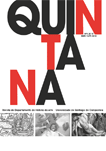Núm. 11 (2012): Arte, natureza e paisaxe, Tema
Recibido: 18-12-2013
Son muchos los artistas que, interesados por la naturaleza, el paisaje y la ecología, se han asociado en los últimos tiempos a la idea de land art. Sin embargo, es preciso una revisión de esta misma categoría, tanto para evitar convertirla en un cajón de sastre como para retomar el estudio de este movimiento e intentar comprender sus nuevas tendencias. En este contexto, la práctica artística debe ser también contemplada como fruto de una evolución y, en consecuencia, susceptible de nuevos análisis. Así, la lectura que se extrae de las obras más significativas de Smithson en nada se asemeja al desarrollo de algunas prácticas de Joseph Beuys o a las pretensiones ecológicas planteadas por Patricia Johanson. Término“fuera de campo”–hors champ–, derivado del mundo de las artes secuenciales, se utiliza aquí para describir el tipo de piezas en las que el espectador, en base a la información que se le aporta, es capaz de aprehender aquello que existe fuera de la obra, lo que es invisible a sus ojos pero no al entendimiento. Al fin y al cabo, el paisaje no se entiende como un elemento autónomo o ajeno al espectador, sino que es un punto de encuentro, un espacio para la interrelación y que convierte el propio arte en diálogo.
Land Art, paisaje, medioambiente, fuera de campo






